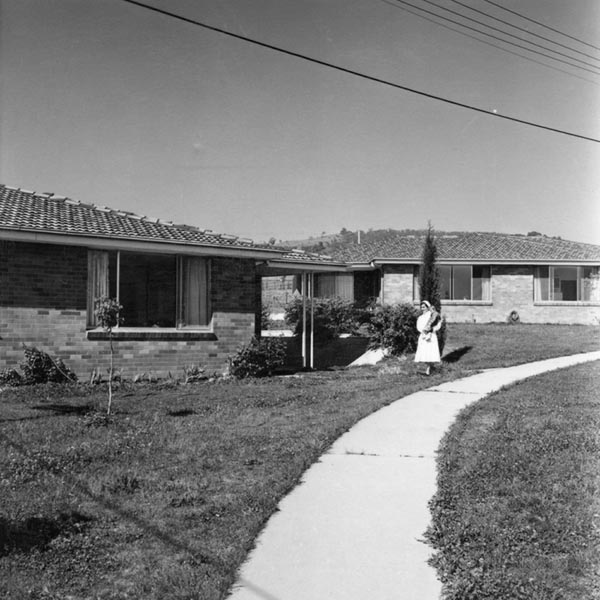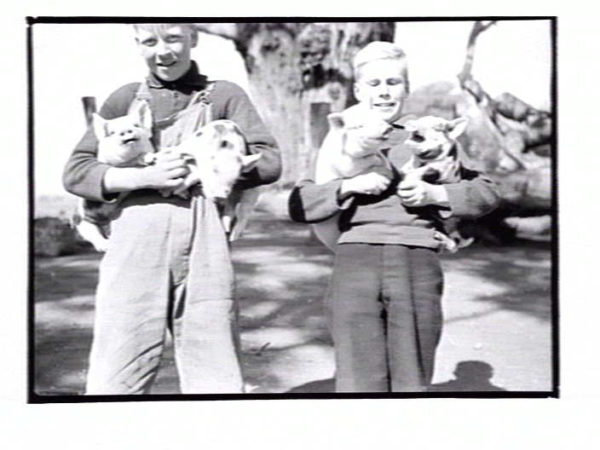
Last Updated: December 17th, 2025
South Australia
1862 - 1929
These six volumes of Registers of admissions to the Industrial School deal with admissions to both the Magill Industrial School (1869-1898) and Edwardstown Industrial School (1898-1950). They contain basic biographical information about children admitted to the Homes such as name, age, parents names and address, religion, reasons for admission, date of discharge, and where they have gone to on discharge. Some entries in the registers mention children transferred to or from the Seaforth Convalescent Home, or the St Vincent de Paul Roman Catholic Orphanage. Sadly there are missing volumes for the periods 1893-1897 and 1909-1912. According to the State Records of South Australia website these registers were destroyed and used as ‘waste paper in connection the war effort’ in 1944. Access Conditions Access to the records in this series is restricted for 100 years in order to protect personal pr

Last Updated: December 16th, 2025
South Australia
1925 - 1976
Records of the Aborigines’ Friends’ Association is an archival series at the State Library of South Australia (Archival number SRG139). It comprises records including correspondence, minutes, reports and financial records. Some of the records relate to missions and institutions, including Point McLeay Mission Station, Colebrook Home and Ooldea Mission. Access Conditions Researchers can have access to documents, photographs, recordings and transcripts held at the State Library of South Australia on presenting their Readers Ticket. Readers Tickets are available from the Library. Records, recordings and transcripts can only be used in the Somerville Reading Room and are not available for borrowing. Access to some material at the State Library may require written permission from the person or organisation that deposited the records. Records The collection records of the Aborigines’ Friends Association at the State Library of South Australia is made up of 56 items r

Last Updated: December 16th, 2025
New South Wales
2006 - 2023
Parragirls was an organisation of over 350 former residents of the Parramatta Girls Home and their supporters, including activists and academics. Parragirls provided a contact register and support network for the Forgotten Australians of the Parramatta Girls Home, Kamballa and related institutions. The organisation was formed in 2006 to lobby for the preservation of the site of the former Female Factory, which later became Parramatta Girls’ Home, and was used as Kamballa, Taldree and the Norma Parker Detention Centre. The organisation also drew attention to the history of the site, as a place for the incarceration of women. In 2017, after significant lobbying by Parragirls, the Parramatta Female Factory and Institutions Precinct was inscribed on the National Heritage List. The inscription notes that “the Precinct is outstanding in its capacity to tell the stories of women and children in institutions over the course of Australian history”. Parragirls works to protect, preserve an

Last Updated: December 16th, 2025
Provenance is the journal of Public Record Office Victoria, the archives of the State Government of Victoria. Hot off the (digital) presses, its 2015 issue features an article written by Find & Connect’s editor, Cate O’Neill. Cate writes about the tragic story of ‘Jill’, a state ward who was in ‘care’ from 1952 until her death in 1955. Read More…

Last Updated: December 16th, 2025
Last week, Charlotte Wood won the Stella Prize for her novel The Natural Way of Things. The Stella Prize celebrates Australian women’s writing and this book explores contemporary misogyny in Australia . In Charlotte’s Stella Interview she spoke about some of the inspirations behind the book: Read More…

Last Updated: December 16th, 2025
The Victorian Government has released a public consultation paper on the subject of redress for victims of institutional child abuse that occurred in government and non-government organisations within Victoria.Read More…

Last Updated: December 16th, 2025
The past few years have seen massive public attention relating to children in immigration detention whether on the Australian mainland or offshore in places like Nauru. While it would be folly to argue the plight of Forgotten Australians, ‘Care’ Leavers and Former Child Migrants is identical to that of children who are in or have experienced immigration detention there are some disturbing similarities. Read More…

Last Updated: December 16th, 2025
Although we’re hearing a lot about the economy, asylum seekers, “jobs & growth”, climate change, negative gearing, health and education during this looooong federal election campaign, it is heartening to see that out-of-home care and supporting young people leaving care are emerging as issues. Read More…

Last Updated: December 11th, 2025
We launched the Find & Connect web resource in November 2011. There is a back-story to the development of this website, and telling it is a good way to reflect on where we’ve come from, how much we’ve learned along the way and where we’re going.Read More…

Last Updated: December 11th, 2025
Australian Capital Territory
1980? - current
Narrabundah House Indigenous Supported Accommodation (NHISA) is run in partnership with government and non government agencies. It provided supported accommodation for young Aboriginal and Torres Strait Islander men aged 12 to 18 years, 24 hours a day, seven days a week. The Australian Institute of Health and Welfare’s Youth justice in Australia 2023–24 report states: The Narrabundah House Indigenous Supported Residential Facility provides crisis, short- to medium-term accommodation options and intensive case management, primarily for Aboriginal and Torres Strait Islander young men aged 14–18 who are on community-based justice orders. The facility provides supported accommodation and culturally based residential programs focused on community participation and integration.

Last Updated: December 11th, 2025
Australian Capital Territory
1986 - 2016
Marlow Cottage, Kaleen, was established in 1986 under the Children’s Services Act 1986 and closed around 2016. It was originally known as Kaleen Youth Shelter and was run by the Welfare Branch, and later the Housing and Community Services Bureau of the ACT Government. It was established to provide accommodation for 12- to 17-year-olds who were on court orders deemed at risk of abuse or neglect, or because they must reside as directed as a condition of bail. In 1995 the Government decided to privatise the operations of the Shelter and tenders were advertised in September 1995. Public outcry ensued, with concerns that the transition from a public sector service was a sign that the government did not want to provide services for the community, that it was a cost-cutting measure, and would potentially put the local community at risk. A motion in the Legislative Assembly narrowly failed to pause the transfer of ownership with the intention to keep it in the public sector. One tender was

Last Updated: December 11th, 2025
Australian Capital Territory
1976 - 2016
Outreach House was established in 1976 and was run by the Richmond Fellowship of the ACT Inc. It provided housing for young people aged 11 to 18 years who were unable to live at home. The program promoted educational opportunities and participation in social and recreational activities. The House closed around 2016.

Last Updated: December 10th, 2025
Australian Capital Territory
2023 - current
Marymead CatholicCare commenced on the 30th June 2023, following a merger of Marymead Child and Family Centre merged with CatholicCare Canberra & Goulburn. Among other services it provides foster care, short-term accommodation for teenagers and young adults, and runs a Permanency Support Program. Marymead CatholicCare provides access to the records of the Marymead Child and Family Centre.

Last Updated: December 10th, 2025
Australian Capital Territory
1967 - 2023
Marymead Child and Family Centre was established in 1967 in Narrabundah. It was run by the Franciscan Missionaries of Mary, until the Catholic Archdiocese of Canberra and Goulburn took over responsibility in 1986. Marymead Child and Family Centre initially provided temporary residential care for children – placed by parents or by welfare officials. When it opened it could accommodate 60 children with 10 in each cottage home. It is estimated that 4,000 – 5,000 children have stayed at the home since it opened. In 2018, Marymead continued to provide residential care for girls and boys aged 5 to 17, as well as family support programs, foster care, disability support, literacy and language support, research into issues impacting children and counselling services. Marymead Child and Family Centre merged with CatholicCare Canberra & Goulburn on 30 June 2023 becoming Marymead CatholicCare Canberra & Goulburn.

Last Updated: December 10th, 2025
Australian Capital Territory
1967 - 2023
Marymead holds over 400 boxes of card files and paper files dating from its inception in 1967 to the present day. The number of files is substantial as thousands of children or young people have stayed at the home and long term residents could be with Marymead for upwards of 10 years. A file has been created for each client in either a card or paper format. The archive also includes a large number of photographs that trace the development of Marymead and features many children who were supported by the organisation. Access Conditions For access to these records please contact Marymead Child and Family Centre. It is a policy of Marymead not to charge clients for copies of their records. Also, clients have the right to add information to their Marymead file, and to insert an amendment should they believe that the information that Marymead holds is not accurate. An electronic database indexing Marymead’s client files has been developed to better assist former clients seeking

Last Updated: December 9th, 2025
Victoria
1948 - current
The Villa Maria Society was established in 1948. Previously it was known as the Catholic Braille Writers’ Association, founded in 1907. From 1938, it ran the Villa Maria Hostel in Prahran, a residence for adult blind people. In 1957, Villa Maria Society established St Paul’s School for the Blind (which continues to operate in 2022 as St Paul’s College). In 2015, Villa Maria merged with Catholic Homes, creating the new organisation Villa Maria Catholic Homes (VMCH).

Last Updated: December 9th, 2025
The Senate report, Betrayal of Trust and the Royal Commission have all made recommendations about the need to provide external oversight to ensure that claims made against institutions, via civil litigation for abuse, are transparent and non‐adversarial. Read More…

Last Updated: December 9th, 2025
A memorial dedicated to children who were in institutional ‘care’ has recently been installed on the Geelong foreshore in Victoria. The hand-carved limestone couch (by local artist Jacinta Leitch) was officially launched in July 2015. Read More…

Last Updated: December 9th, 2025
Victoria
This photograph was taken at Northcote Training Farm school, Glenmore, Victoria. It shows two boys (presumably residents of the training farm) each holding two piglets.

Last Updated: December 9th, 2025
Wattle Place hosts a regular interagency meeting of services in the Sydney area who hold care records. At one of our recent meetings we invited Barbara Reed of Recordkeeping Innovation to speak about her work with the Department of Social Services and the creation of the Access to Records by Forgotten Australians and Former Child Migrants Read More…

Last Updated: December 9th, 2025
Tasmania
c. 1907 - 2006
The Ministering Children’s League of Tasmania Collection is held at the Queen Victoria Museum and Art Gallery (QVMAG), Launceston. It contains records dating from c.1907 to 2006 that relate to the administration and activities of the Minstering Children’s League Tasmanian branch. Access Conditions These records are open access, and can be viewed by appointment at the Archives and History Centre of the Queen Victoria Museum and Art Gallery in Launceston. For access to this collection please contact QVMAG. Records The records of the Minstering Children’s League in Tasmania were donated to the Queen Victoria Museum and Art Gallery in 2006. They contain primarily administrative records relating to the activities of the MCL. A small number of records in this collection relate to the Ministering Children’s League Convalescent Home (1900-1950), however it does not appear that this collection contains any records relating to children at the home. The collection include
